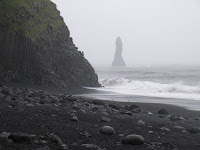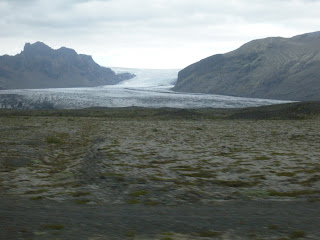Monday, 6 September 2010
Thank you to all Students!
The Hotel




The meals were superb, with both breakfast and supper being buffet style, many pupils went back for seconds or thirds although the three courses we had in the evenings meant that some did not feel the need to! The quality of the food was also excellent and helped to contribute to a great atmosphere amongst the group.
Seljalandsfoss (Part 2) – Friday 3rd September




Following a group photo, we spent a few minutes bathing in the waterfalls beauty before climbing up another rocky pathway and returning to the coach for the journey back to Hotel Hafnarfjordur. We were even lucky enough to see a huge and complete rainbow as we left the car park. A spectacular ending to a spectacular trip!
Verity (Year 10)
Seljalandsfoss (Part 1) – Friday 3rd September




Hannah (Year 9)
Skogafoss – Friday 3rd September



Reynisfjara Beach – Friday 3rd September


David and Toby (Year 9)
Jokulhlaup Damage – Thursday 2nd September


Friday, 3 September 2010
The Laki eruption and Eldhraun Lava Flow - Friday 3rd September

Next we started to explore the Lava Flow, we found that it was covered in moss (which was very springy). The moss and soil were formed by the process known as “succession”. This is after the Lava has solidified and layers of vegetation have grown over the top. The Lava travelled 50km before it solidified.
We noticed the Lava Flow was much bigger than first anticipated, and it formed small mounds. We enjoyed walking over the Lava Flow as the moss was so springy underfoot.
Zak and Liam (Year 9)
Skaftafell National Park - Thursday 2nd September



Next, we took a short(ish) walk down to the Glacier, stopping several times to show us the erosion on the mountain. When we arrived near to the glacier, he gave us a picture of the same spot, taken in 1994, it was amazing how much of the glacier had retreated in the past 16 years. Despite how much it had shrunk, the sheer vastness of the ice was mind-blowing; reaching hundreds of metres wide.
There are many of these great glacial valleys across Iceland, as the country is in fact 11 per cent ice. In front of the glacier were lagoons, formed by melted ice.
Callum and Lucy (Year 9)
Jokulsarlon - Thursday 2nd September (Part Two)





Whilst walking along the shore we found some ice-blocks that had been washed on to the rocks. We were amazed by the patterns that the air bubbles created in the ice. George found himself a small iceberg, which he was very proud of. We also followed in Mr. Pittam’s footsteps and found ourselves becoming avid rock collectors, searching intently to find pieces of volcanic rock. We were looking for black rocks with air bubbles in, which would have happened when the lava solidified. They are black due to traces of the mineral Basalt.
We also saw the effects of global warming in action as we witnessed one of the icebergs snapping in half and crashing into the water. Jokulsarlon is home to some fascinating wildlife, such as seals, and various species of bird, including Eider Ducks, the Great Skua and the Red-Throated Diver.
Before leaving we took a walk down to a very unusual beach, that had black sand and Icebergs in the sea! It was strangely beautiful and the whole experience was radical!
By Sophie, Beth and Hannah.
Jokulsarlon (Part 1) - Thursday 2nd September





After a few group photos with the icebergs behind us we went down to the shore of the lagoon. A lot of us journeyed down to the beach where some icebergs lay stranded.
The group that were left sat around on the shore looking for seals. Suddenly there was an almighty crunch and a large slab of ice broke away from the structure and the back sank raising the front end out of the water. Wow!
After we soaked up the lagoons natural beauty we piled back onto the coach and traveled to Skaftafell Park.
Amelia (Year 10)
Journey East - Thursday 2nd August



The journey along route 1 was really smooth (being a newly tarmaced road - the majority of raods leading off route 1 were invariably dirt tracks!) and apart from the clouds and rain following us along the coast we have had a fantastic two days as the pupils reports will highlight. We also saw lots of amazing sights from the coach as we travelled; from waterfalls plunging off towering escarpments to 11 mile wide glaciers; geothermal-powered greenhouses to various lava flows and awe-inspiring damage caused by glacial floodwaters to steel bridges! Unfortunately Hekla (an active volcano) was obscured by cloud and whilst we passed within 10 miles of Eyjafjallajokull, we couldn't see it since it remains under an ice cap.
Our hostel for our overnight stay on Thursday was quaint but comfy and had fantastic views. We are now back in our excellent hotel in Hafnarfjordur.
CP
Wednesday, 1 September 2010
Whale Watching - Wednesday 1st September

At 13:00 we left the Reykjavik harbour on a converted fishing boat, to set sail to see some whales. After a 45minute boat journey we were informed to look for Gannets (large seabirds) which feed on the same fish as the Minke Whales do, so after spotting the birds, we saw a whale. When the whales surface they create a still area of water called a footprint. Also, how arched their backs are when they surface, determines how deep they dive. They can hold their breath for up to 20 minutes at a time and can go much deeper than the bay which was only 30-40 meters deep. As the whales only surface for a few seconds, and with the tour guide constantly shouting different directions, the whales were pretty much impossible to get on camera. I thought that the best part of the whale watching trip was constantly trying to spot whales. Also the boat journey was great fun with everyone getting on really well having shared in a fantastic experience!
Aidan and Sam (Year 10)
[Minke Whale photo by Rachel]
Reykjavik Tour - Wednesday 1st September




Hveragerđl Geothermal Power Station - Tuesday 31st August

As we entered the modern looking power station, we were greeted by our tour guide who conducted a brief presentation, explaining the aims of the power plants. By 2012, they are aiming to produce 300 mega watts, which is enough to supply the total population of Iceland with “green” electricity. Most of it will go into industry however, although the plant will supply the majority of hot water to Reykjavik!
After this we were shown upstairs, first to a diagram presentation of how the energy is produced… apparently on the biggest touch screen in Europe. After this we were shown further upstairs where we were shown some sounds of earthquakes in Iceland (in 1998, 2001, 2005 and 2008). After this we were shown the generators and steam extractors before our tour finished.
During the tour, we were told that, in Iceland, the water is treated with hydrogen sulphide, because there is too much oxygen in the water which causes corrosion in pipes. It also reduces the waters boiling level so that the water is more efficient. However even when treated, a smell remains which is similar to rotten eggs, this means that all of the hot water in Iceland smells of egg…: seriously, this is not good!
George and Ben (Year 10)







